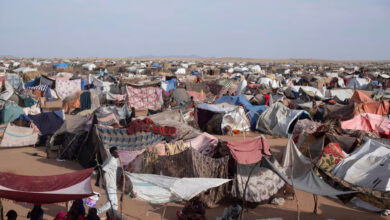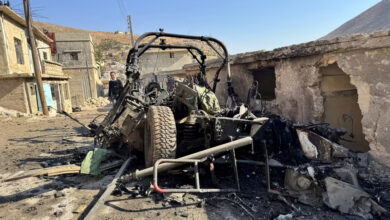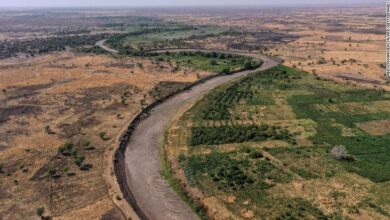
The Iraqi Kurds’ independence referendum that was just held could mean further instability in the Middle East, where formal borders have remained in place for decades but recent conflicts have resulted in several de facto partitions.
The vote is not binding, and opposition from the international community, as well as Iraq and its neighbors, makes any formal separation unlikely. But the poll has escalated tensions between the Kurds and Iraq’s Arab majority, raising fears of unrest.
The Kurds already enjoy virtual statehood in their autonomous zone in northern Iraq, which was established after the 1991 Gulf war and formalized following the US-led invasion of 2003. The Kurds boast their own government, parliament and armed forces, and Kurdish flags in the region far outnumber Iraqi ones.
That kind of de facto partition, once rare in the Mideast, has become far more common in the chaos that followed the 2011 Arab Spring.
Here is some background on secession and informal breakups in four Arab nations:
___
SUDAN
It always seemed to be just a matter of time before the mainly animist and Christian south of Sudan would break away from the Muslim and Arab north of the vast country. In July 2011, South Sudan became the world’s newest nation, following an overwhelmingly “yes” vote in an independence referendum held seven months earlier.
The vote was part of a 2005 peace deal that ended a civil war with heavy ethnic and religious undertones between the north and the south that began in 1983. An earlier civil war in Sudan lasted 17 years.
Now, South Sudan is mired in a new civil war, pitting the members of the Dinka tribe, traditionally South Sudan’s powerhouse, against the Nuer.
The 2011 secession robbed the Khartoum government of most of its energy resources, with many of the oilfields now south of the border. It also has underlined the Arab world’s seeming inability to accept and invest in the diversity of its population. The strong secessionist sentiment in southern Sudan was fueled by the perceived injustices by successive Khartoum governments, discriminating against the southerners and denying them a fair share of the national wealth.
___
LIBYA
For all practical purposes, Libya has been carved up by rival administrations, one based in the capital of Tripoli and the other in the eastern city of Tobruk. An army general backed by Egypt, the United Arab Emirates and several Western nations is fighting militant Islamic groups in the eastern, central and southern parts of the country as he pursues his goal of uniting Libya under his leadership.
The chaos and lawlessness are the result of the uprising against dictator Moammar Gadhafi that came amid the 2011 Arab Spring. The revolt soon turned into a civil war that resulted in mostly Islamist militias becoming the real source of power, carving up fiefdoms of influence and showing little or no respect for government authority.
The division, underpinned by historical tribal rivalries between eastern and western Libya, has meant minimal popular interaction between the two parts of the oil-rich nation and dual diplomatic representation abroad. Fighting by rival militias over oilfields and export terminals frequently flares up, deepening the country’s instability.
___
YEMEN
The impoverished nation in the southwest corner of the Arabian Peninsula has always been somewhat chaotic, with the central government wielding weak authority. So when Yemen slipped into its latest civil war in 2014, the country appeared to come unglued easily.
Now, Iranian-backed Shiite rebels and their allies control the capital of Sanaa and much of northern Yemen, while government troops and allied militias are in charge in the south. That division of spheres of influence has in effect carved up the country. The country also has been under a sea, ground and air blockade by a Saudi-led coalition fighting on the government’s side, with Sanaa’s airport closed for more than a year and flights to southern destinations, like Aden, significantly curtailed.
The war also has fueled secessionist sentiment in the south, a region that was an independent, socialist nation until 1990 when it entered a union with the conservative north. Southerners rebelled against the union in 1994, but their forces were crushed by the north.
___
SYRIA
Syria’s vexingly many-tiered civil war has produced a northeastern enclave controlled by the main Syrian Kurdish party, known as the PYD, which has benefited from a tacit nonaggression pact with President Bashar Assad’s government since the early months of the war in 2011. At the time, the Syrian army withdrew from much of northeastern Syria to battle rebels elsewhere.
The PYD’s armed wing, the People’s Protection Units, or YPG, later expanded that enclave by battling the Islamic State group with the aid of US airstrikes.
The Kurds also drove westward. In August 2016, they captured the town of Manbij, a key Islamic State supply hub west of the Euphrates River. The move triggered a Turkish military intervention in Syria. Ankara sent its troops across the border, effectively severing Kurdish plans to form a contiguous territory stretching along the border from west to east Syria, and pushing them nearly 100 kilometers (60 miles) back from the border.
___
This story has been corrected to show that the Gulf War was in 1991, not 1990; and that the Syrian town of Manbij was retaken in August 2016, not last month.




